
Opalarten: Eine umfassende Liste der Opalarten, ihrer Herkunft, Farben und mehr!
 Opale sehen aus, als würden sie Galaxien bergen, aber wussten Sie, dass es unzählige Opalarten gibt? Opale, die vor allem als Geburtsstein für Oktober bekannt sind, sind faszinierende Naturwunder und in zahlreichen Varianten erhältlich!
Opale sehen aus, als würden sie Galaxien bergen, aber wussten Sie, dass es unzählige Opalarten gibt? Opale, die vor allem als Geburtsstein für Oktober bekannt sind, sind faszinierende Naturwunder und in zahlreichen Varianten erhältlich!
Wenn es um Opalarten und ihre Bedeutungen geht, symbolisieren Opale im Allgemeinen Hoffnung und Unschuld, aber die Bedeutung eines Opals kann je nach Opalart variieren.
Welche Arten von Opalen gibt es also?
Heute beschäftigen wir uns mit allen Opalarten und zeigen Bilder, sortiert nach Kategorie, Herkunft und Farbe. Bevor wir beginnen, erklären wir zunächst, wie man Opale klassifiziert.
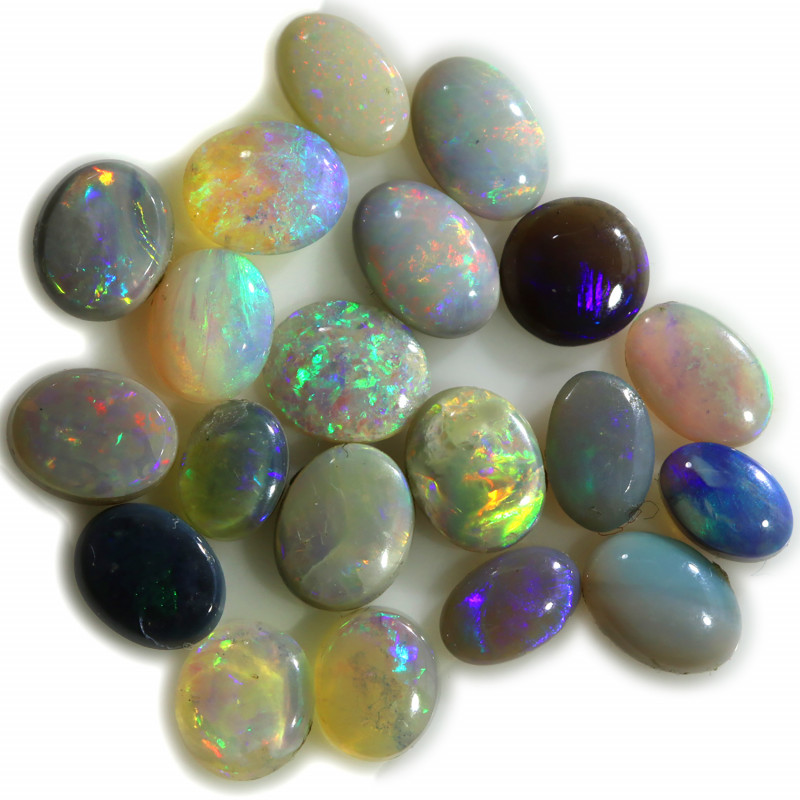
Welche Opalarten gibt es?
Weltweit gibt es Hunderte von Opalarten, doch die erste Unterscheidung, die man kennen sollte, ist die zwischen gewöhnlichen und kostbaren Opalen . Kostbare Opale weisen ein irisierendes Farbenspiel auf, gewöhnliche Opale hingegen nicht.
Opale werden primär nach ihrer Körperfarbe klassifiziert. Der Fachbegriff dafür ist Körperton, wobei auch die Begriffe „Grundton“ oder „Hintergrundfarbe“ verwendet werden.
Bei Edelopalen bezeichnet der Körperton die relative Dunkelheit oder Helligkeit des Steinhintergrunds. Bei gewöhnlichen Opalen basiert der Körperton einfach auf der Gesamtfarbe des Steins.
Weitere Gruppierungskriterien umfassen die Herkunft, Einschlüsse und Entstehung des Opals. Bevor wir darauf eingehen, welche drei verschiedenen Opalarten sind bei Käufern am beliebtesten?
Die beliebtesten Opalarten
Trotz der Vielzahl an verschiedenen Opalarten nehmen drei Opaltypen eine führende Rolle ein: weißer/heller Opal, grauer/dunkler Opal und schwarzer Opal.

Weiß/Hellopal
Als heller oder weißer Opal bezeichnet man jeden Opal mit einem Körperton der Farbklasse N7-N9. Er kann sowohl gewöhnlich als auch kostbar sein. Helle Opale reichen von farblos bis hellgrau, während weiße Opale einen weißen bis blassgrauen Körper aufweisen. Diese Opale können transparent bis halbdurchsichtig sein, haben aber meist einen milchigen Schimmer.
Weiß ist die häufigste Opalfarbe und die am weitesten verbreitete Edelopalart. Die australische Coober-Pedy-Mine trägt aufgrund ihres Reichtums an weißen Edelopalen den Beinamen „Opalhauptstadt der Welt“.

Grau/Dunkelopal
Grauer oder dunkler Opal liegt farblich zwischen Weiß und Schwarz und hat einen Grauton von N5-N6. Diese auch als „Halbschwarze Opale“ bezeichneten, häufigen oder kostbaren Opale weisen einen mittelgrauen Grundton auf, der nicht dunkel genug ist, um als Schwarzopal zu gelten. Der Großteil des dunklen Opals stammt aus Lightning Ridge oder Mintabie in Australien. Diese Opalart ist seltener als weißer Opal, zeigt aber ein intensiveres Farbenspiel.
Apropos dunkle Opale: Welche ist die seltenste Opalart?
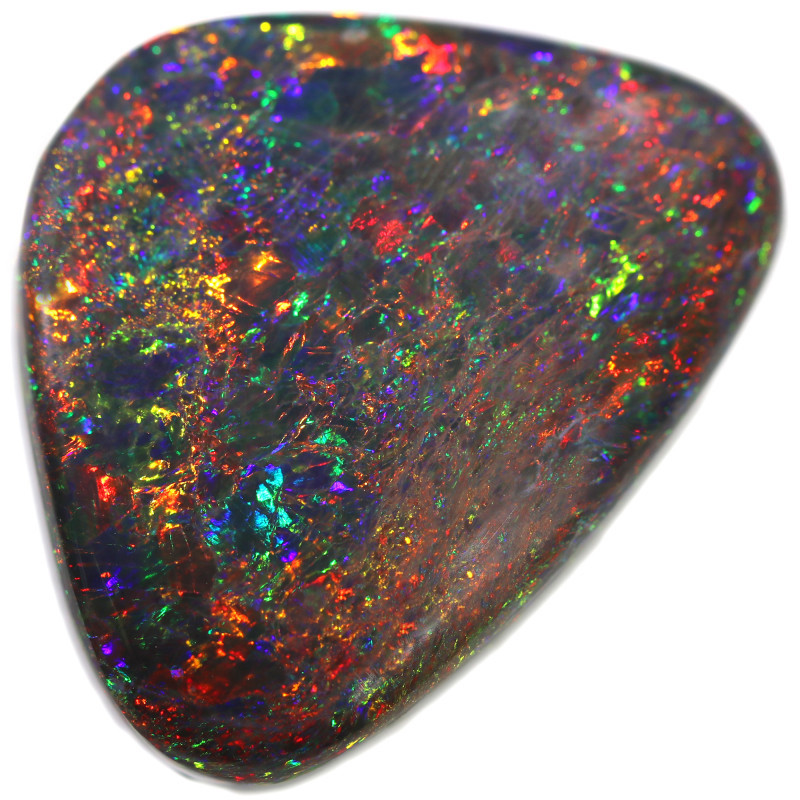
Schwarzer Opal
Schwarzer Opal ist die seltenste Opalvarietät und zeichnet sich durch einen dunkelgrauen bis schwarzen Körperton (N1-N4) aus. Es gibt ihn als transparenten oder undurchsichtigen schwarzen Kristallopal , wobei sowohl gewöhnliche als auch wertvolle schwarze Opale erhältlich sind.
Obwohl selten, stammen die meisten schwarzen Opale in Edelsteinqualität aus Lightning Ridge, Australien. Schwarzer Edelopal weist das intensivste Farbenspiel aller Opale auf. In welchen anderen Farben gibt es Opale?
Opale nach Körperfarbe
Neben Weiß, Grau und Schwarz gibt es Opale auch in Rosa, Violett (Morado), Blau, Grün, farblos und in feurigen Farbtönen. Lasst uns jeden einzelnen genauer betrachten!

Rosa Opal
Rosa Opal ist eine häufig vorkommende Opalart in einem hellen bis bonbonrosa Farbton, obwohl auch andere Farben wie Weiß, Gelb, Pfirsich, Lavendel und Schwarz vorkommen können. Diese Opalart weist häufig Einschlüsse auf, die dunkle Streifen oder Farbzonen erzeugen.
Rosa Opale stammen aus Australien, Mexiko und den USA, Peru ist jedoch die ergiebigste Quelle. Peruanische rosa Opale zeichnen sich durch einen milchigen Ton und eine leuchtende, gleichmäßige Farbe aus, insbesondere der „rosa Andenopal“.
Die rosa Opale Westaustraliens sind eigentlich opalisierte Radiolarite und oft stark eingeschlossen (d. h. sie enthalten Spuren anderer Mineralien oder Ablagerungen), wodurch weiße, braune oder schwarze Muster entstehen.
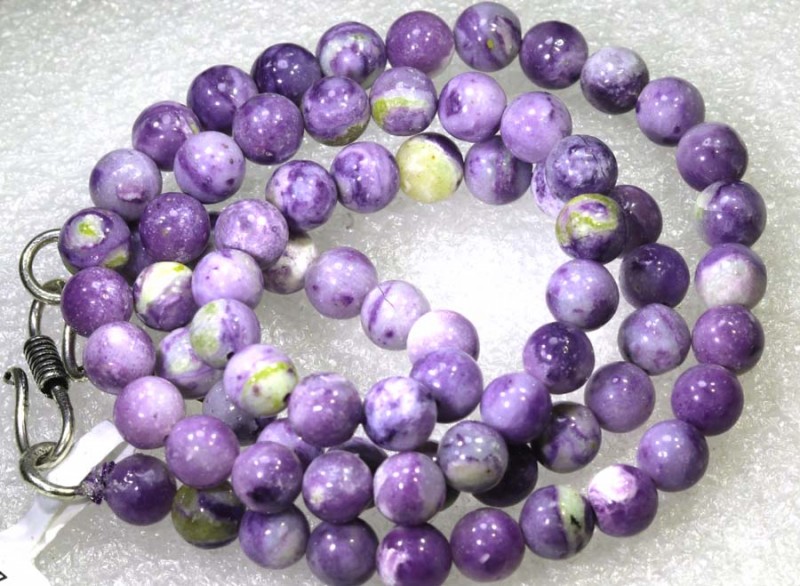
Morado-Opal
Morado-Opal, auch „Purpuropal“ oder „Opal Royale“ genannt, ist eine in Mexiko heimische, violette Opalvarietät. Die Farben reichen von Lavendel bis Violett und sind typischerweise milchig und undurchsichtig. Violette Farbtöne finden sich auch im Tiffany-Opal , einem Opal-Fluorit-Konglomerat aus Utah, USA, das durch Fluorgase violett gefärbt wird.

Blaue Opale
Blaue Opale können gewöhnlich oder kostbar sein und reichen von tiefem Türkis bis zu hellem Himmelblau. Peru ist vor allem für diese Varietät bekannt, und der Begriff „blauer Opal“ bezeichnet oft den peruanischen gewöhnlichen blauen Opal. Peru produziert aber auch kostbare blaue Opale, und einige Steine weisen in kleinen Bereichen ein Farbenspiel auf.
Brasilien gehört neben Peru zu den Produzenten des seltenen blaugrünen Paraiba-Opals. Weitere Minen für blaue Opale befinden sich in der Slowakei, Indonesien und den USA, darunter die pastellblauen Owyhee-Opale aus Oregon.
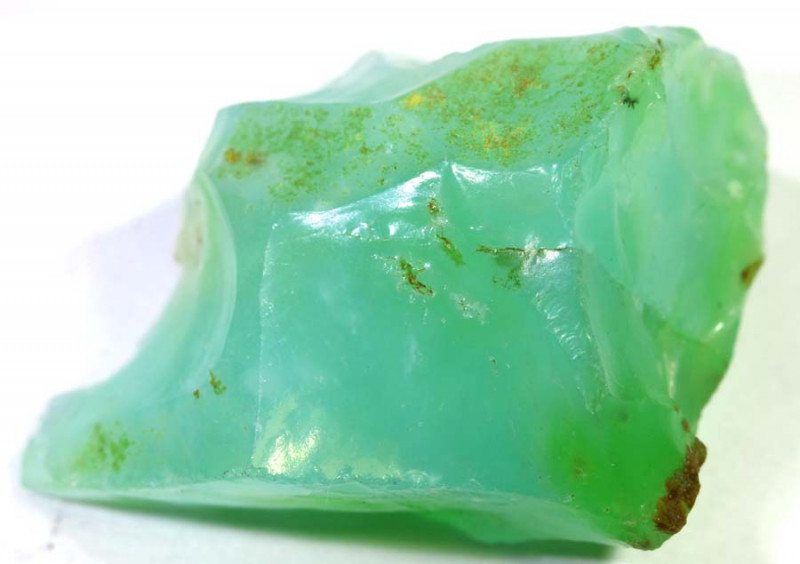
Grüne Opale
Eine weltweit verbreitete Opalart ist der grüne Opal , der in leuchtenden Smaragd-, Gelbgrün- oder Jadegrüntönen vorkommt. Er findet sich auf sechs Kontinenten, die bedeutendsten Vorkommen liegen jedoch in Australien, Brasilien, Peru, Mexiko und den USA.
Natürlicher Opalit ist eine weitere grüne Opalvarietät, die jedoch auch violette Schattierungen aufweist. Opalit ist typischerweise moosgrün mit dunklen dendritischen Einschlüssen und kann Chatoyance (den Katzenaugeneffekt) zeigen. Die meisten Exemplare stammen aus Afrika, aber der Katzenaugen-Opalit aus Äthiopien ist oft honigfarben oder gelb.
Eine weitere grüne Opalart ist der tansanische Prase-Opal . Diese Varietät enthält Nickel, was dem Stein eine leuchtend neonblaue Farbe verleiht. Prase-Opale sind durchscheinend bis transparent und werden daher auch als „afrikanische Jade“ bezeichnet.
Als Nächstes stellt sich die Frage: Welche Farbe von Opal ist am wertvollsten? Das wäre roter Opal, der zufälligerweise auch die wertvollste Farbe von Feueropal ist.
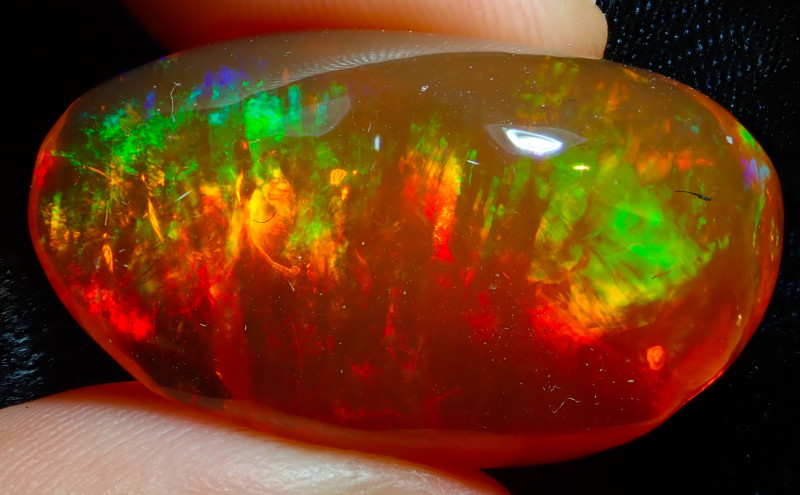
Feueropal
Lieben Sie ein feuriges Farbenspiel? Dann sind Feueropale genau das Richtige für Sie. Feueropale gibt es in Rot-, Orange-, Gelb- und Brauntönen , und sie können sowohl gewöhnlich als auch kostbar sein. Ursprünglich aus Mexiko stammend, werden diese Steine oft als mexikanische Feueropale bezeichnet, obwohl sie auch in Australien und Äthiopien vorkommen.
Feueropale unterscheiden sich von den meisten Opalen dadurch, dass sie durchscheinend bis transparent (nicht undurchsichtig) sind und in Vulkanen entstehen. Die meisten mexikanischen Feueropale sind gewöhnliche Opale, Äthiopien hingegen produziert wertvolle Feueropale mit neonvioletten und grünen Farbreflexen.

Farbloser Opal
Außerhalb des Regenbogens gibt es farblose Opalarten. Obwohl ihnen die Farben der oben genannten Opale fehlen, besitzt jede von ihnen einzigartige Eigenschaften.
Kristallopal : Jeder Edelopal, der farblos und transparent ist, keine Trübung aufweist und auf der Körperskala N7-N8 aufweist.
Jelly-Opal / Wasseropal : Transparente, farblose Edelopale, die etwas dunkler als Kristallopale sind und ein gelatineartiges Aussehen haben, manchmal mit einem inneren Farbenspiel und blauem oder goldenem Schimmer.
Contraluz Opal : Aus dem Spanischen übersetzt bedeutet dies „gegen Licht“. Farblose Edelopale zeigen ein Farbenspiel im Inneren des Opals, wenn man den Stein von der Rückseite beleuchtet.
In der nächsten Kategorie finden wir Opalarten, die durch die Bildung mit anderen Materialien definiert sind.
Opale Einschlüsse & Varietäten
Die meisten Opale entstehen durch ähnliche Prozesse. Reagiert ein Opal jedoch während seiner Entstehung mit benachbarten Mineralien und Partikeln, kann ein völlig neuer Opaltyp entstehen. Der Opal und andere Materialien können sich äußerlich verbinden, indem der Opal um ein anderes Mineral herumwächst, oder innerlich, indem Einschlüsse im Opal eingeschlossen werden.
Als Einschlüsse bezeichnet man jegliches Material, das während der Entstehung eines Edelsteins darin eingeschlossen wurde. Während die meisten oberflächlichen Bestandteile eines Steins als „Fehler“ bezeichnet werden, können innere Einschlüsse manchmal bis zur Oberfläche reichen.
Wenn Sie sich fragen, welche Opalart die beste ist, würden viele sagen, die erste Mineralkombinations-Opalart auf unserer Liste: Boulderopal!

Boulder Opal
Boulderopal ist eine Kombination aus Edelopal und Wirtsgestein, typischerweise Eisenstein oder Sandstein, obwohl einige Exemplare anstelle von Gestein auch Vegetation oder versteinertes Holz enthalten.
Edelopal tritt als Flecken und/oder dünne Adern auf, die am Wirtsgestein anhaften oder von diesem umgeben sind. Dies geschieht, wenn vorgebildetes Opal-Kieselsäurewasser in die Spalten des Gesteins sickert, bevor der Opal aushärtet.
Queensland, Australien, war das erste Fundgebiet für Boulderopal und ist nach wie vor ergiebig. Weitere Fundorte für Boulderopal sind Brasilien und Kanada.
Boulder-Opale weisen einige Unterarten auf:
Boulder-Opal-Holzfossil : Diese Varietät, auch als fossiler Holzersatzopal bezeichnet, enthält opalisiertes Holz, das am Wirtsgestein haftet.
Andamooka Boulder Opal : Diese seltenen Opale werden in Andamooka, Australien, abgebaut, haben Quarzit-Wirtsgesteine und werden manchmal auch „Painted Ladies“ genannt.
Opalnuss : Opalnüsse, die in den australischen Opalvorkommen Yowah und Koroit vorkommen, sind abgerundete Boulderopale, die einer Baumnuss ähneln und eine deutliche Bänderung aufweisen. Boulderopale aus diesen Vorkommen besitzen typischerweise eine schokoladenbraune Eisensteinrückseite, während andere Minen Steine mit hellbrauner Rückseite fördern.
Boulder Pipe Crystal Opal : Diese Varietät enthält Kristallopal, der sich in hohlen oder röhrenförmigen Zylindern innerhalb des Wirtsgesteins gebildet hat.
Cantera-Opal : Diese Art besteht aus Feueropal oder Edelopal in rosa Rhyolith.
Boulder-Opale können auch als Boulder-Matrix-Opale vorkommen, eine Unterart, die sich mit unserer nächsten Varietät vermischt: Matrix-Opal!
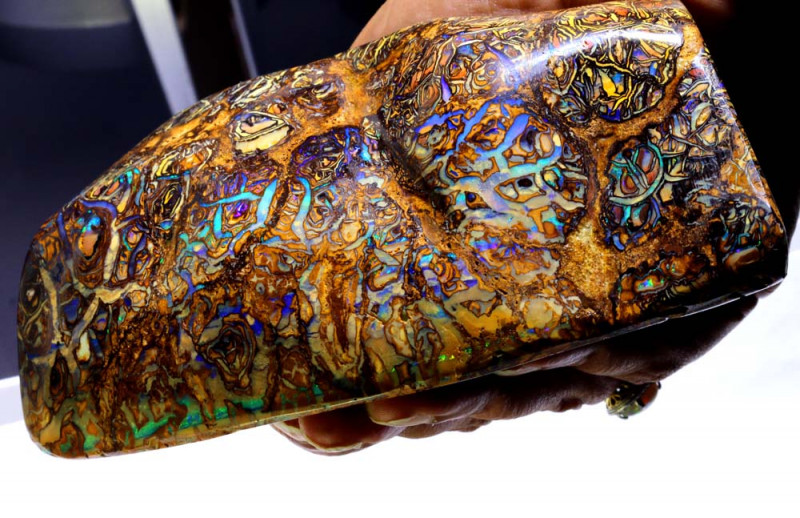
Matrix Opal
Wie Boulderopal enthält auch Matrixopal Edelopal, das mit dem Wirtsgestein verwoben ist. Im Gegensatz zum Boulderopal füllt der Edelopal beim Matrixopal jedoch die Hohlräume oder Poren zwischen den Körnern des Wirtsgesteins, wodurch ein gleichmäßigeres Farbenspiel im gesamten Stein entsteht, anstatt in abgegrenzten Bereichen.
Matrixopal stammt aus Mexiko, Honduras und Australien. Der australische Andamooka-Matrixopal ist porös und lässt sich daher leicht (und häufig) chemisch behandeln , um seine Farbe zu verbessern. Honduras produziert hauptsächlich Matrixopal, dessen opake Variante typischerweise ein dunkles Wirtsgestein aufweist, das mit leuchtenden Opalpartikeln durchsetzt ist.
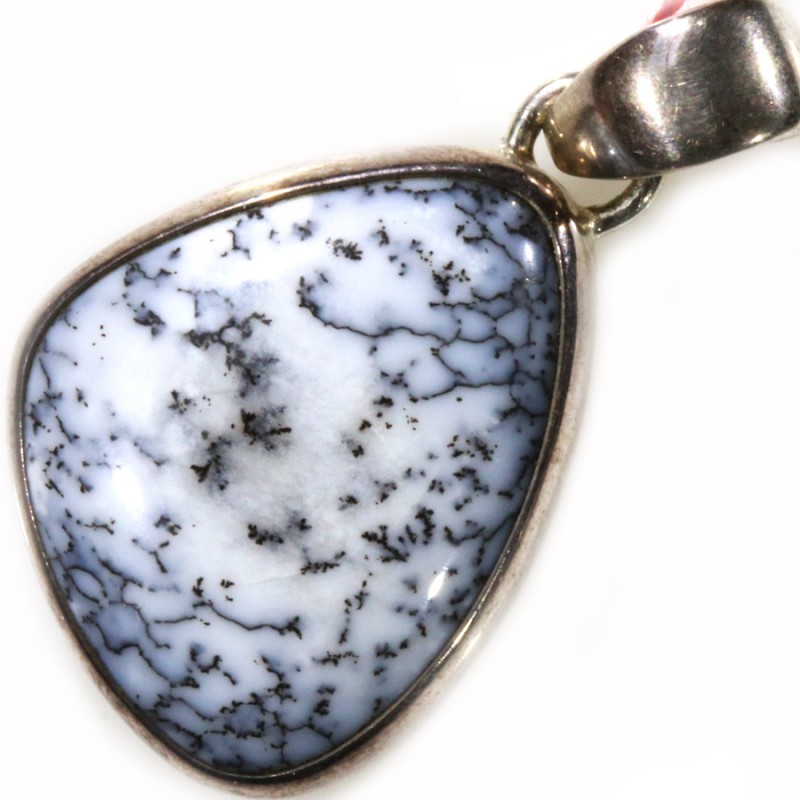
Dendritischer Opal
Dendritenopal , auch Moosopal genannt, ist eine weiße oder gelbbraune Opalart, die sich durch grüne oder braune, moosartige (dendritische) Einschlüsse auszeichnet. Diese Einschlüsse, oft Mangan oder Eisen, bilden einzigartige Muster, darunter solche, die an Waldlandschaften erinnern und bei Landschaftsopalen zu finden sind.
Dendritische Opale können fast 30 Prozent Wasser enthalten, wodurch sie als „weiche Edelsteine“ eingestuft werden. Die meisten dieser Opale stammen aus Australien, Mexiko oder den USA , aber man findet sie auch in ganz Mittelamerika, Asien und Russland.
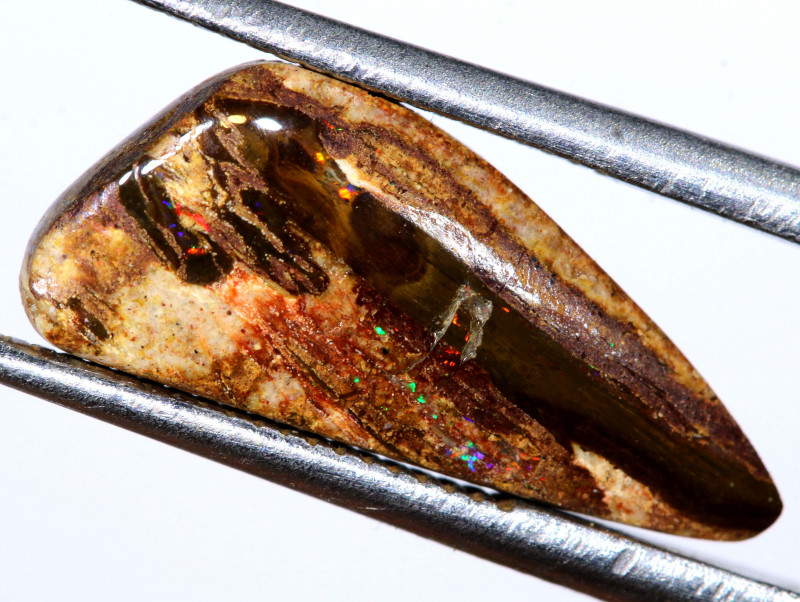
Opalisiertes Holz
Opalisiertes Holz ist eine Art versteinertes Holz, das Opal enthält. Versteinertes Holz ist fossilisiertes Holz oder Pflanzenmaterial, bei dem ein Teil der Pflanze durch Gestein, in diesem Fall Opal, ersetzt wurde!
Diese irdischen Schönheiten entstehen, wenn Kieselsäurewasser vergrabenes Holzgewebe konserviert. Wo tritt dieses Naturphänomen auf? Opalisiertes Holz bildet sich häufig in Wäldern, die von Asche bedeckt sind. Bedeutende Vorkommen befinden sich in den USA, Indonesien, Russland, Mexiko und Brasilien.
Ausgehend von natürlich entstandenen Kombinationen wollen wir uns als nächstes ansehen, wie Menschen Opale mit anderen Materialien kombinieren.
Kompositopale
Die meisten Opale sind massiv und bestehen zu 100 % aus Opal. Natürliche Opale, die beispielsweise mit anderen Materialien vermischt sind, gelten nicht als massiv. Der wichtigste Unterschied liegt jedoch zwischen massiven und zusammengesetzten Opalen . Zusammengesetzte oder „assemblierte“ Opale wurden von Juwelieren bearbeitet und umfassen Dubletten, Tripletts und Mosaik-/Chip-Opale. Warum sollte man ein so makelloses Naturprodukt verändern? Zusammengesetzte Opale sind für Verbraucher erschwinglich und stellen daher eine attraktive Alternative zu echten Opalen dar.
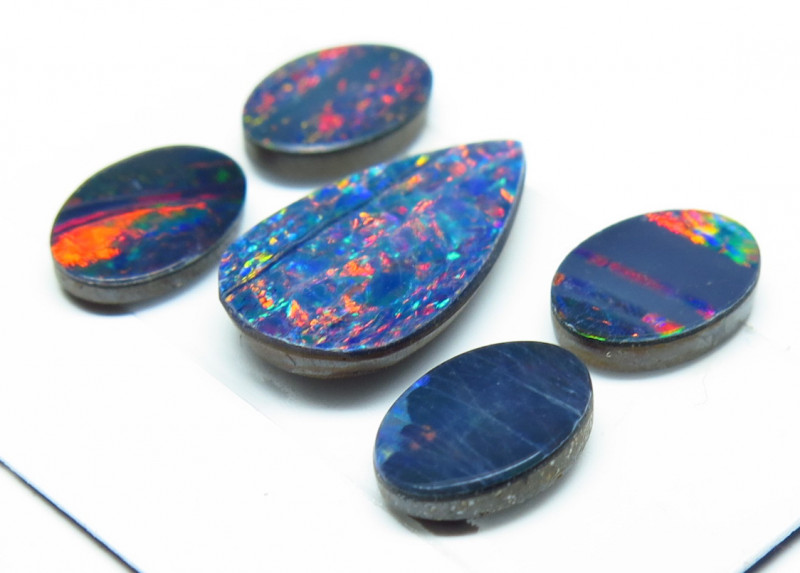
Doublet-Opale
Doublet-Opale sind zusammengesetzte Opale, bei denen eine dünne Scheibe Edelopal auf eine Trägerschicht geklebt ist. Diese Trägerschicht kann aus Eisenstein bestehen, um Boulderopal zu imitieren, aus einem anderen Mineral oder aus Kunststoff. Oft wird heller Edelopal auf eine schwarze Trägerschicht geklebt, um schwarzen Edelopal nachzuahmen.
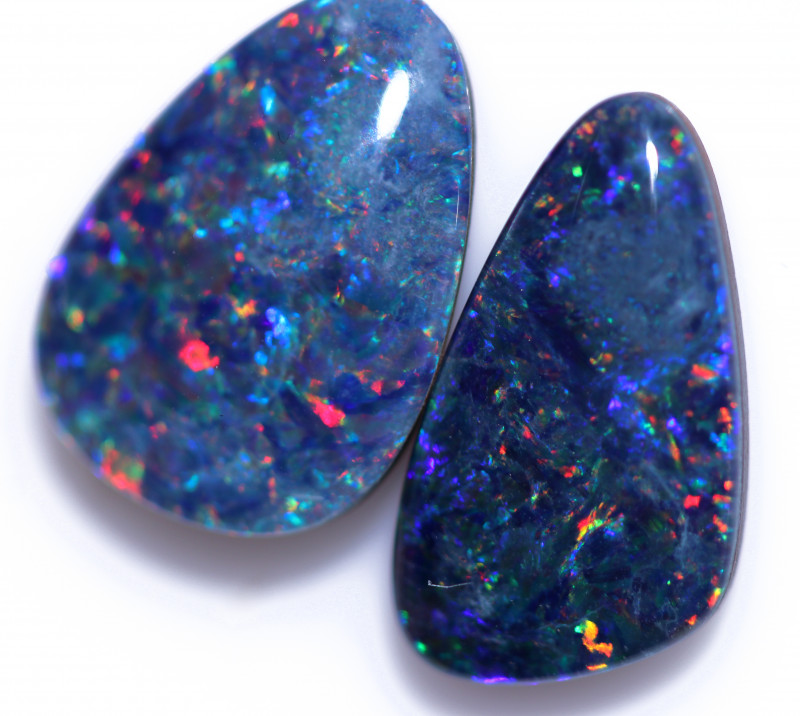
Triplet-Opale
Opal-Tripletts sind im Grunde Doubletten mit einer schützenden Kristallkuppel, die aufgeklebt ist. Die Kuppel kann aus Glas, Quarz oder Kunststoff bestehen und verstärkt zudem das Farbenspiel des Steins. Tripletts sind in der Regel günstiger als Doubletten, da weniger Opal verwendet wird.

Mosaik- und Splitteropale
Mosaik- und Splitteropale sind zwei Arten von zusammengesetzten Opalen, bei denen einzelne Opalstücke zu einer neuen Form zusammengesetzt werden. Bei Mosaikopalen werden kleine, flache oder unregelmäßig geformte Stücke wie Buntglas auf einen dunklen Untergrund geklebt. Für Splitteropale werden die Opalstücke mit Harz vermischt und in einem Behälter ausgehärtet, bis sie die gewünschte Form annehmen.
Bevor Juweliere Opale aus verschiedenen Materialien herstellen können, müssen Minenarbeiter die Steine finden. Da es so viele Opalarten gibt, stellt sich die Frage: Wo auf der Welt findet man Opale?
Geologische Faktoren und die Topografie, die sich von Region zu Region stark unterscheiden, haben den größten Einfluss auf die Art eines Opals. Boden, Atmosphäre und Mineralien, die einen Opal formen, variieren weltweit – begeben wir uns also auf eine Weltreise!
Opale nach Quelle
Jede Opalmine weltweit hat sich in der Regel auf eine bestimmte Opalart spezialisiert. Begleiten Sie uns auf unserer Reise zu den Opalminen der Welt und lernen Sie ihre Besonderheiten kennen!
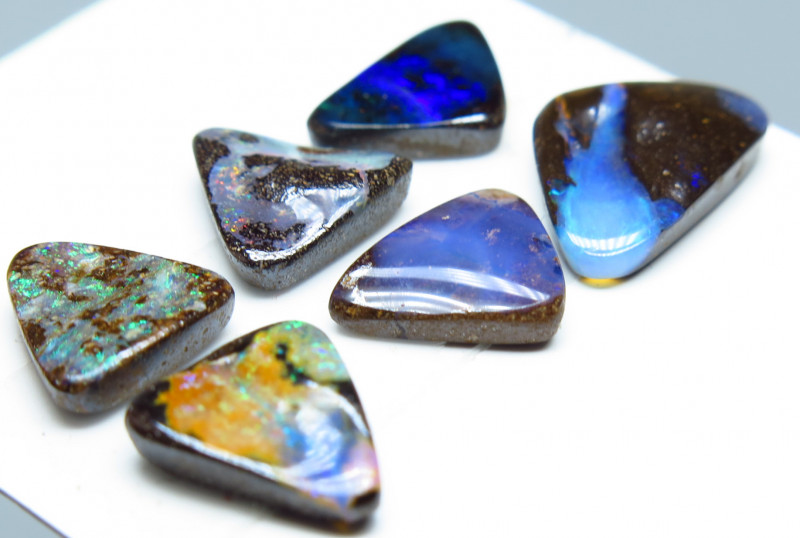
Australische Opale
Es ist kein Geheimnis, dass Australien der weltweit größte Opallieferant ist. Das liegt daran, dass Australien über eine Reihe bedeutender Abbaugebiete verfügt, die jeweils für unterschiedliche australische Opalarten bekannt sind:
Andamooka : Bekannt für seinen leuchtenden Kristallnahtopal.
Coober Pedy : Hauptproduzent von weißem Opal.
Lightning Ridge : Größter Opalproduzent nach Wert und bekannt für seine hochwertigen schwarzen Opale.
Queensland: Beherbergt die Opalvorkommen und Minen von Koroit und Yowah , die fast alle Boulderopale der Welt liefern.
Tintenbar : Produziert vulkanischen dunklen Gelee-Opal.
White Cliffs Opal : Bekannt für weißen und kostbaren Aderopal sowie opalisierte Ananasfossilien.
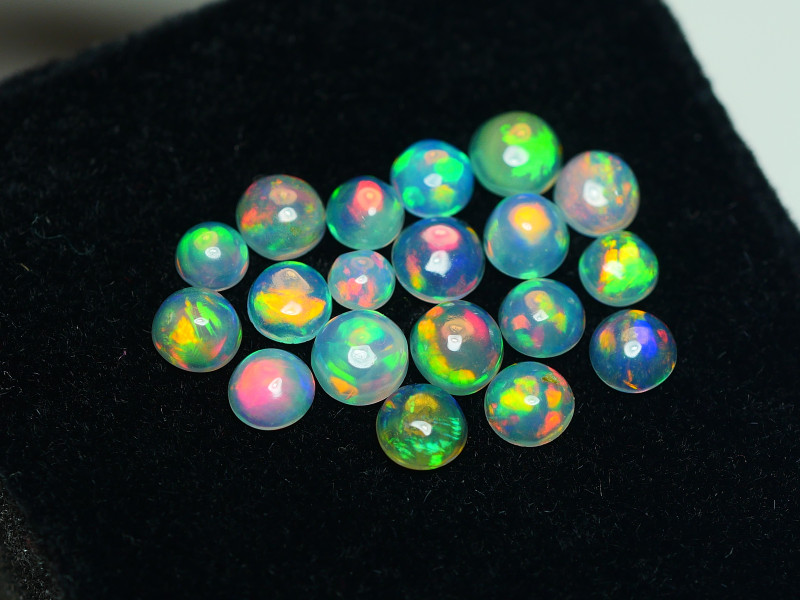
Afrikanische Opale
Die Entdeckung mehrerer Opalvorkommen in Äthiopien in den letzten Jahrzehnten hat Afrika zu einer wichtigen Quelle auf der Opallandkarte gemacht.
Äthiopischer Opal : Bekannt für seine Hydrophanopale mit lebhaftem Farbenspiel und kostbaren schwarzen oder weißen Opale.
Tansanischer Opal : Produziert den wertvollsten Opal.
Madagaskar-Opal : Kürzlich entdeckte Pyrophanopale und Girasol-Feueropale.
Kenianischer Opal : Bekannt für die ältesten Opalreste und olivgrüne gewöhnliche Opale.
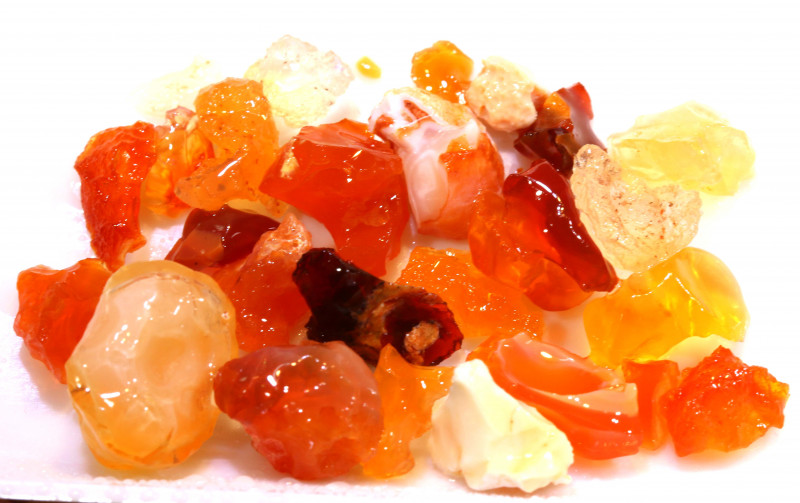
Mittel- und Südamerikanischer Opal
Mexikanischer Opal : Mexiko ist vor allem für seine Feueropale bekannt, produziert aber auch Madera-Opale, Contra-Luz-Opale, Cantera-Boulder-Opale und einige der besten Wasseropale der Welt.
Brasilianischer Opal : Bekannt für seinen Kristallopal mit pastellfarbenen Reflexen und niedrigem Feuchtigkeitsgehalt.
Peruanischer Opal : Bekannt für seinen blauen oder rosafarbenen peruanischen Opal, der gleichzeitig der Nationalstein des Landes ist.
Honduranische Opale : Bekannt für die ältesten Opalminen der Welt und die Produktion einzigartiger Boulder- und Matrixopale.
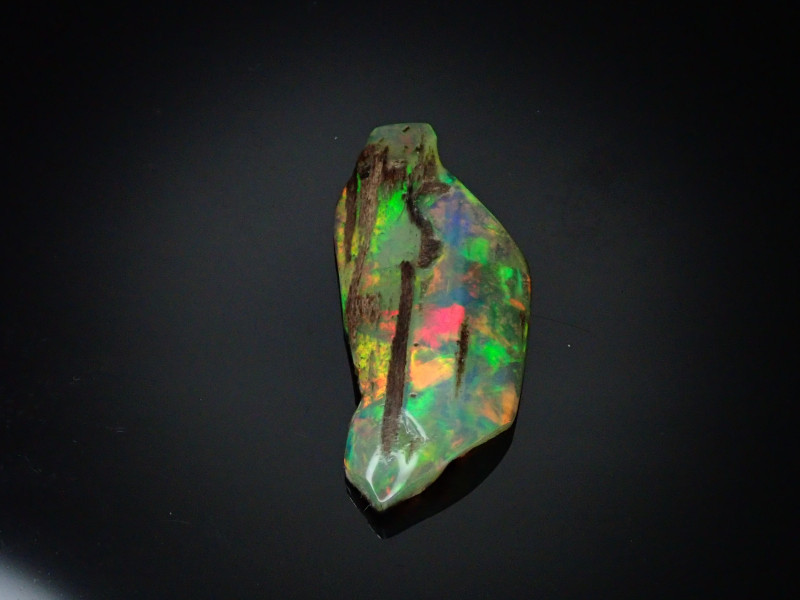
Andere Standorte
Indonesische Opale : Bekannt für natürlichen Opalit und opalisiertes Holz.
Amerikanische Opale : Hauptsächlich aus Idaho , Utah und dem Virgin Valley stammend, zählen zu den bemerkenswerten amerikanischen Varietäten Owyhee-Opale, „Thunderegg“-Opale, Regenbogenopale, dendritische Opale, opalisiertes Holz, Hyalit, gebänderte Opale, Louisiana-Sandopale und Utah-Speckopale.
Slowakische (oder ungarische) Opale : Ausgeprägte weiße Edelopale mit inneren blauen und orangen Farbreflexen.
Andere Opalarten
Manche Opale lassen sich nicht eindeutig einer Kategorie zuordnen, aber man sollte sie nicht übersehen!
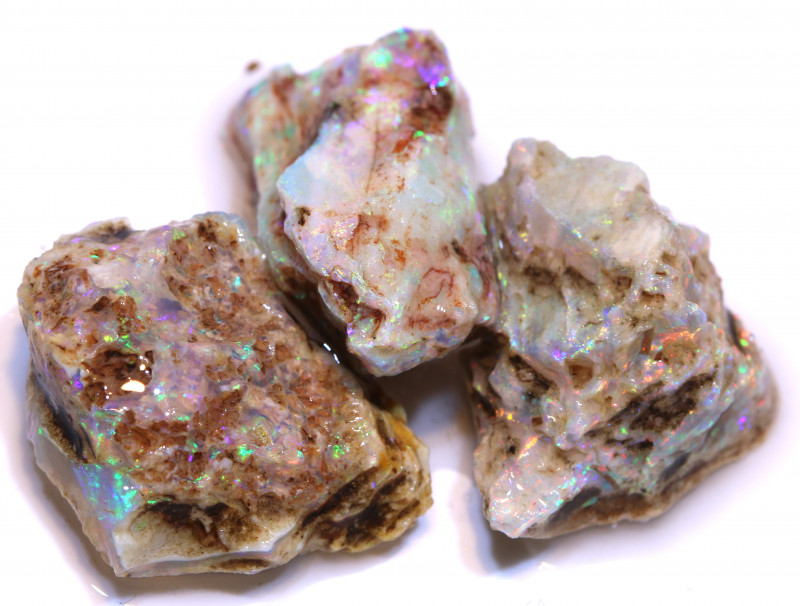
Opalisierte Fossilien
Ähnlich wie Wackelpuddingformen füllt Kieselsäurelösung die in Gesteinen hinterlassenen Fossilienabdrücke und härtet zu opalisierten Fossilien aus! Diese Opale können sich in Fossilien von Tierschädeln, Muscheln , Ananas und sogar in 100 Millionen Jahre alten Tintenfischen, den sogenannten opalisierten Belemniten , bilden. Obwohl sie hauptsächlich in Australien gefunden werden, haben Bergleute opalisierte Fossilien auch in den USA, Ungarn und Indonesien entdeckt.
Welcher Opal ist der teuerste? Man mag es kaum glauben, aber es ist ein opalisiertes Fossil! Der Virgin Rainbow gilt mit über einer Million Dollar als einer der teuersten Opale der Welt, wenn nicht sogar als der teuerste. Tatsächlich handelt es sich um ein opalisiertes Fossil eines ausgestorbenen Kopffüßers namens Belemnitida.

Hyalit
Hyalit ist eine besondere Opalart, Opal-AN genannt, ein amorpher Opal mit einer netzartigen Struktur, ähnlich wie Glas. Diese farblose, blassgelbe oder grüne Opalvarietät enthält keine Siliciumdioxid-Kügelchen und zeigt kein Farbenspiel, es sei denn, sie weist Einschlüsse auf.
Das auffälligste Merkmal von Hyalit ist seine grüne Fluoreszenz, die durch seinen Urangehalt verursacht wird. Das starke Leuchten tritt unter UV-Licht oder direktem Sonnenlicht hervor.
Synthetische Opale
Die Begriffe „synthetisch“, „Simulant“ und „Imitation“ können Käufer verwirren. Sie alle bezeichnen künstlich hergestellte Opale, aber Simulant-Opale haben die gleiche chemische Zusammensetzung wie natürliche Opale, während Imitations-Opale lediglich ein ähnliches Aussehen aufweisen.
In der Gemmologie bezeichnet „synthetisch“ streng genommen Opalimitationen. Eine Ausnahme bildet synthetischer Opalit, ein künstlich hergestelltes, opalisierendes Glasharz.
Die am häufigsten hergestellten synthetischen Opale sind schwarze oder weiße Opale, aber es sind verschiedene Imitations- und Nachahmungsvarianten entstanden:
Sterling Opal (Monarch Opal) : Synthetischer Opal, der 2016 eingeführt wurde und in verschiedenen Farben und mit schwarzen, linearen Mustern erhältlich ist, die Potch-Einschlüssen ähneln.
Aurora-Opal : Teils synthetischer Opal aus Siliziumdioxid und Harz, erhältlich in sieben Körperfarben und mit einzigartigen Wirbelmustern.
Drachenatem-Opal : Imitationsopal mit Opaleszenz, aber ohne Farbenspiel, hergestellt aus tschechoslowakischem Glas, erscheint rubinrot, wechselt aber beim Drehen in blaue und violette Farbtöne.

Welcher Opal passt zu Ihnen?
Damit sind alle Opalarten auf dieser vollständigen Liste abgedeckt! Jetzt, da Sie alle Opalarten und ihre Bedeutungen kennen, welche ist Ihre Lieblingssorte? Falls Sie sich nicht entscheiden können, entdecken Sie die Hunderte von verfügbaren Opalsorten und finden Sie die richtige für sich!
Entdecken Sie noch heute Ihre Lieblingsopalart!
Suche nach Opal Encyclopedia
Verwandte Auktionen
In Verbindung stehende Artikel
Der Boulder-Opal zählt zu den wertvollsten und am meisten unterschätzten Opalen auf dem Markt. Erfahren Sie mehr über diesen einzigartigen Opal und entdecken Sie die wunderschönen Steine in unserem Angebot.
29th May 2019
In dieser Anleitung erfahren Sie, wie Sie Boulder-Opal schleifen und polieren. Das Schleifen dieses Steins kann knifflig sein, daher geben wir Ihnen hier einige Tipps.
23rd May 2018
Neue Artikel
Schwarze Opale sind die begehrteste Opalart. Ihre tiefe Basis erzeugt ein regenbogenfarbenes Farbenspiel an der Oberfläche. Entdecken Sie die Verwendung, Eigenschaften, Geschichte und den Wert schwarzer Opale!
7th Dec 2025
Erfahren Sie, wie Opale bewertet werden und welche Faktoren ihren Preis beeinflussen. Von Farbe und Leuchtkraft bis hin zu Schliff und Herkunft – lernen Sie, wie die verschiedenen Opalarten bewertet werden, inklusive Preisbeispielen.
19th Jul 2023
Begeben Sie sich auf eine Reise und erfahren Sie von unserer Gastautorin Vivien Schapera von Crystal Healing Techniques mehr über die Heilkraft von Opalen!
20th May 2023
Artikelkategorien
All there is to know about Opals including Black Opals, Ethiopian Opals & Boulder Opal
14 Artikel
Check out our fascinating information and articles on all things amazing in the Opal world
41 Artikel
Opal Auctions sellers who are approved as opal Verified Sellers
4 Artikel





![NEW LINE OPAL IN SHIN CRACKER.[ JP46 ] 48.18 CTS FROM SE](https://liveplatforms-production.b-cdn.net/tenants/oa/uploads/images/15000-19999/19844/9ca0531b82f41ed23bd44a7af1c6477a.jpg?width=480&aspect_ratio=1001%3A1000)
![NEW LINE OPAL IN SHIN CRACKER.[ JP45 ] 62.92 CTS FROM SE](https://liveplatforms-production.b-cdn.net/tenants/oa/uploads/images/15000-19999/19843/caf197f5a1485faa4eff333924bfa12e.jpg?width=480&aspect_ratio=1001%3A1000)
![NEW LINE OPAL IN SHIN CRACKER.[ JP43 ] 61.40 CTS FROM SE](https://liveplatforms-production.b-cdn.net/tenants/oa/uploads/images/15000-19999/19841/61c6376b6fcc08a3bb770826eeb62c35.jpg?width=480&aspect_ratio=1001%3A1000)
![NEW LINE OPAL IN SHIN CRACKER.[ JP42 ] 65.95 CTS FROM SE](https://liveplatforms-production.b-cdn.net/tenants/oa/uploads/images/15000-19999/19840/05ee9a5bbf3ea08840b9c6539e28534d.jpg?width=480&aspect_ratio=1001%3A1000)